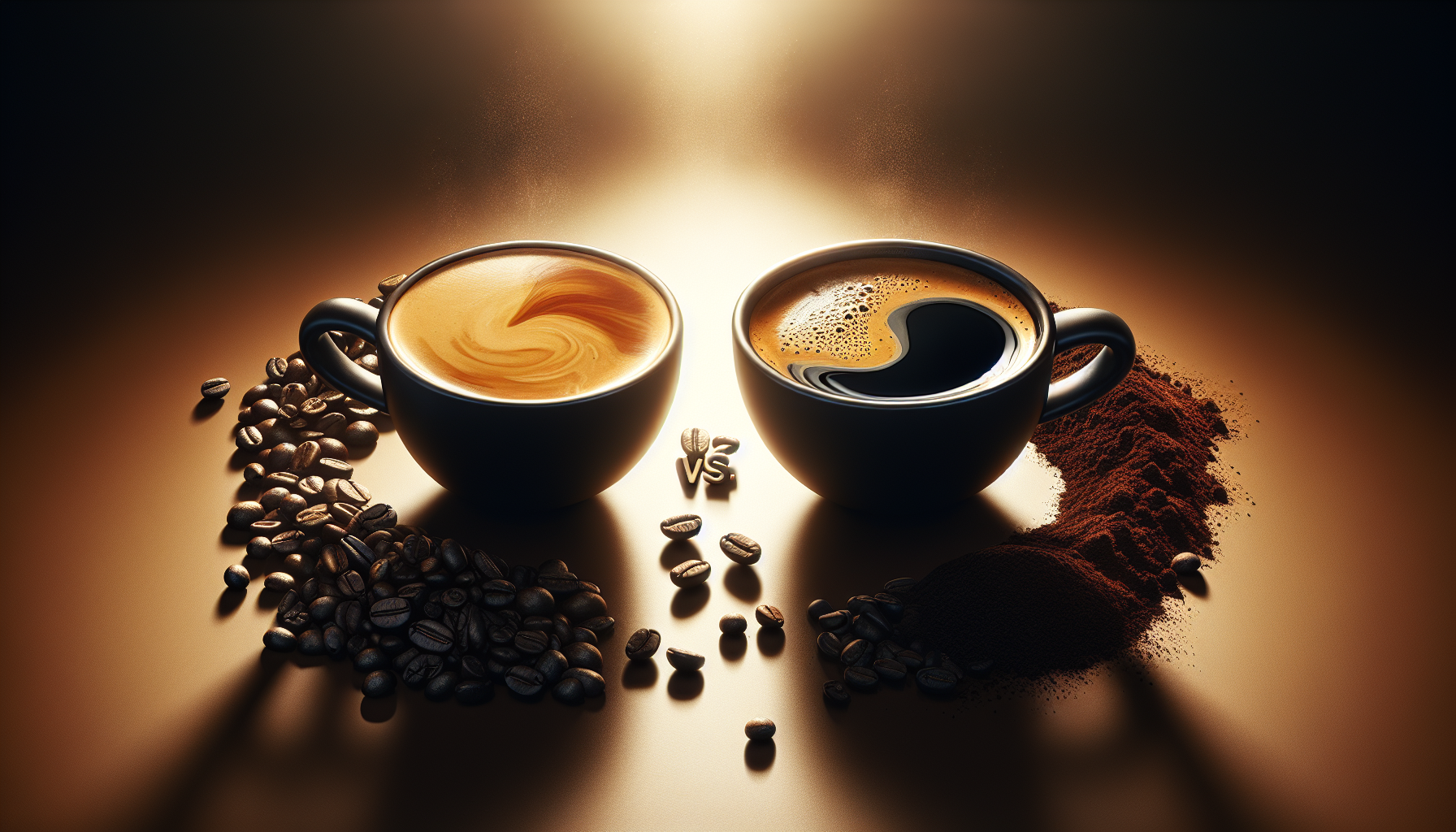Imagine waking up in the morning and craving a caffeinated kick to start your day. As you stand in line at your favorite coffee shop, the thought suddenly crosses your mind: Is a cup of coffee stronger than an espresso? You’ve heard people debate the two, but today, we’re here to settle the score. In this article, we will examine the strength and potency of both a cup of coffee and an espresso, helping you gain a deeper understanding of these popular caffeinated beverages. So, grab your favorite mug and get ready to explore the world of coffee!

CHECK OUT ESPRESSO MACHINES ON AMAZON
The Difference Between Coffee and Espresso
The Brewing Process
One of the key differences between coffee and espresso lies in the brewing process. Coffee is typically brewed by steeping ground coffee beans in hot water for a certain period of time, usually using a drip or pour-over method. This allows the water to extract the flavors and compounds from the coffee grounds, resulting in a rich and aromatic beverage.
On the other hand, espresso is made using a specialized machine that forces hot water through finely ground coffee under high pressure. This rapid extraction process results in a concentrated and intense shot of coffee that is typically smaller in volume compared to a regular cup of coffee.
The Coffee-to-Water Ratio
Another difference between coffee and espresso is the ratio of coffee to water used in the brewing process. When making coffee, a common ratio is usually around 1 to 15 or 1 to 18 (1 part coffee to 15 or 18 parts water). This allows for a milder and less concentrated cup of coffee.
Espresso, on the other hand, requires a higher coffee-to-water ratio. The general rule of thumb is a ratio of 1 to 2 or 1 to 3 (1 part coffee to 2 or 3 parts water), resulting in a stronger and more concentrated shot of espresso.
Caffeine Content
The caffeine content in coffee and espresso can also differ. While the brewing process and serving size play a role in determining the caffeine content, espresso is generally considered to have a higher concentration of caffeine per ounce compared to regular coffee.
Taste and Flavor Profiles
Coffee Taste and Flavor
Coffee is known for its wide range of taste and flavor profiles, which can vary depending on factors such as the origin of the beans, the roasting process, and the brewing method used. Common flavor notes found in coffee include fruity, nutty, chocolatey, floral, and earthy undertones. The taste of coffee is often described as a balance between bitterness, acidity, and sweetness.
Espresso Taste and Flavor
Espresso, due to its concentrated nature, has a more intense and robust flavor compared to regular coffee. It tends to have a bolder taste with notes of caramel, chocolate, and even hints of smokiness. The shorter extraction time of espresso allows for the preservation of more complex flavors, resulting in a beverage that is often associated with a rich and full-bodied taste.
Comparing the Strength of Coffee and Espresso
Defining Strength in Coffee Terms
When discussing the strength of coffee, it refers to the intensity of flavors, body, and overall impact. A stronger coffee may have a bolder taste, higher concentration of compounds, and a more noticeable caffeine kick. This can be influenced by factors such as the coffee beans used, the brewing method, and the coffee-to-water ratio.
Defining Strength in Espresso Terms
In the context of espresso, strength refers to the concentration of flavors and compounds achieved through the brewing process. Espresso is known for its potent and concentrated taste, resulting in a beverage that is often perceived as stronger than regular coffee. The intensity of flavors and aroma in espresso can be attributed to the high-pressure extraction method and the smaller serving size.
Caffeine Content in Coffee and Espresso
Measuring Caffeine in Coffee
The amount of caffeine in a cup of coffee can vary depending on factors such as the brewing method and the type of coffee beans used. On average, an 8-ounce cup of brewed coffee contains around 95 milligrams of caffeine. However, it’s important to note that caffeine content can range from 30 milligrams to over 200 milligrams per cup.
Measuring Caffeine in Espresso
Espresso, being a concentrated form of coffee, generally contains a higher amount of caffeine per ounce compared to regular coffee. A 1-ounce shot of espresso typically contains around 63 milligrams of caffeine. However, since the serving size of espresso is much smaller, the overall caffeine content consumed in a single serving is generally lower than that of a regular 8-ounce cup of coffee.
Perceived Effects on the Body
Coffee Effects
The effects of coffee on the body can vary from person to person due to individual tolerance and sensitivity to caffeine. Generally, coffee consumption can provide an energy boost, increased alertness, and improved focus. It may also stimulate the central nervous system and enhance physical performance. However, excessive consumption or sensitivity to caffeine can lead to side effects such as jitters, increased heart rate, and disrupted sleep patterns.
Espresso Effects
Due to its higher concentration of caffeine, consuming espresso can have a more pronounced and immediate effect on the body. Similar to coffee, espresso can provide a surge of energy, heightened focus, and improved cognition. However, these effects may be more intense and profound due to the concentrated nature of espresso. It is important to note that individual reactions to caffeine can vary, and moderation is key to avoiding negative side effects.
Health Benefits and Risks
Coffee Health Benefits
Coffee has been the subject of numerous studies exploring its potential health benefits. Some research suggests that moderate coffee consumption may be associated with a decreased risk of certain conditions such as type 2 diabetes, Parkinson’s disease, liver disease, and certain types of cancers. Coffee is also a rich source of antioxidants and may provide temporary improvement in mental performance and mood.
Espresso Health Benefits
As a concentrated form of coffee, espresso may offer similar health benefits associated with moderate coffee consumption. However, it is important to note that these potential benefits are largely attributed to the coffee beans themselves, rather than the brewing method. Espresso, consumed in moderation, can contribute to the overall antioxidant intake and potentially offer the same health benefits as regular coffee.
Coffee Health Risks
While coffee is generally considered safe for most people, there are potential risks associated with excessive consumption or individual sensitivity to caffeine. Excessive coffee intake can lead to negative effects such as increased heart rate, high blood pressure, gastrointestinal issues, and disrupted sleep. Pregnant women, individuals with certain medical conditions, or those highly sensitive to caffeine should exercise caution and consult with a healthcare professional.
Espresso Health Risks
Similarly, excessive consumption of espresso can lead to the same potential health risks associated with high caffeine intake. It is important to be mindful of personal tolerance and sensitivity when consuming espresso, as the concentrated form may lead to more immediate and intense effects. Moderation and listening to your body’s reactions are key to enjoying espresso without adverse health effects.
Preferences and Personal Taste
Factors Affecting Preferences
Coffee and espresso preferences are highly individualized and can be influenced by various factors. Personal taste preferences, cultural influences, geographical location, and familiarity with certain brewing methods all play a role in shaping one’s preference for either coffee or espresso. Additionally, factors such as desired strength, caffeine content, and the desired drinking experience can also impact which beverage individuals prefer.
Personal Taste Preferences
Some individuals may prefer the milder and more nuanced flavors of coffee, appreciating the variety of taste profiles offered by different beans and roasts. Others may gravitate towards the bold and intense flavors of espresso, enjoying the concentrated nature of the shot. Ultimately, personal taste preferences dictate which beverage individuals find more enjoyable and satisfying.
Usage in Culinary Recipes
Incorporating Coffee in Recipes
Coffee is a versatile ingredient that can be used in a variety of culinary recipes to enhance flavors and add complexity. Its rich and distinct taste can be incorporated into both sweet and savory dishes, ranging from desserts like tiramisu and coffee-infused chocolate cakes to savory recipes such as coffee-rubbed steaks or coffee-based marinades. The depth of flavors that coffee brings to dishes can elevate the overall dining experience.
Incorporating Espresso in Recipes
Similarly, espresso can be used as an ingredient in culinary creations to enhance flavors and provide a robust coffee punch. Its concentrated form allows for a more pronounced coffee taste in recipes such as espresso-flavored cookies, espresso chocolate mousse, or espresso-infused sauces for meat or pasta dishes. The intensity of espresso can bring a delightful richness and depth to various culinary creations.
CHECK OUT ESPRESSO MACHINES ON AMAZON
Serving Sizes and Presentation
Standard Coffee Serving Sizes
Coffee is typically served in varying sizes, ranging from small 6-ounce cups to larger 12-ounce mugs. The choice of serving size often depends on personal preference, cultural customs, and the desired caffeine intake. It is important to note that the caffeine content and taste profile can vary depending on the serving size, as a larger cup of coffee may have a milder taste due to a higher coffee-to-water ratio.
Standard Espresso Serving Sizes
Espresso is traditionally served in small, 1-ounce shots. This size provides the optimal balance of concentration and flavor. However, a double shot of espresso, which is around 2 ounces, is also common and suitable for those who prefer a more potent coffee experience. The small serving size of espresso allows for a quick and concentrated consumption, making it an ideal choice for those seeking a strong and efficient caffeine kick.
Presentation and Aesthetics
When it comes to presentation, both coffee and espresso can be served in various ways to enhance the overall aesthetic appeal. For coffee, it is common to see it served in a mug or a cup, often accompanied by cream, milk, or flavorings such as cinnamon or cocoa powder. Espresso, on the other hand, is usually served in a small ceramic or glass cup, allowing the rich crema on top to be showcased. Some prefer to add a slice of lemon or a sugar cube on the side for optional taste variations.
Price and Accessibility
Coffee Price and Accessibility
Coffee beans and ground coffee are widely accessible and come in a variety of price ranges, depending on factors such as origin, quality, and brand. The availability of coffee and its affordability make it a popular choice for daily consumption, and it can be easily purchased from local grocery stores, coffee shops, or online retailers.
Espresso Price and Accessibility
Espresso machines and espresso-based beverages tend to be more expensive compared to regular coffee. The specialized equipment required for making espresso, such as espresso machines and grinders, can come with a higher price tag. Additionally, purchasing espresso shots or espresso-based drinks from coffee shops can be more costly than a regular cup of coffee. However, with the increasing popularity of home espresso machines, the accessibility of espresso has improved, allowing enthusiasts to enjoy their favorite beverage without needing to visit a coffee shop.
In conclusion, the difference between coffee and espresso lies in the brewing process, coffee-to-water ratio, taste profiles, strength, caffeine content, effects on the body, health benefits and risks, personal preferences, usage in culinary recipes, serving sizes, presentation, price, and accessibility. Both coffee and espresso have their unique qualities and are beloved by coffee enthusiasts worldwide. Whether you prefer the milder and nuanced flavors of coffee or the intense and concentrated punch of espresso, both beverages offer a delightful and energizing experience. So, the next time you find yourself at a cafe or brewing a cup at home, remember the differences and let your personal taste guide you in enjoying a cup of coffee or a shot of espresso just the way you like it.

